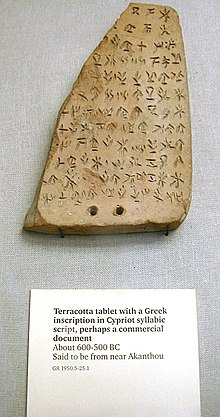Cypriot syllabary
| Cypriot |
|
|---|---|
 |
|
| Type |
Syllabary
|
| Languages | Arcadocypriot Greek, Eteocypriot |
|
Time period
|
11th–4th centuries BCE |
|
Parent systems
|
Linear A
|
| Direction | Right-to-left |
| ISO 15924 | Cprt, 403 |
|
Unicode alias
|
Cypriot |
| U+10800–U+1083F | |
The Cypriot or Cypriote syllabary is a syllabic script used in Iron Age Cyprus, from about the 11th to the 4th centuries BCE, when it was replaced by the Greek alphabet. A pioneer of that change was king Evagoras of Salamis. It is descended from the Cypro-Minoan syllabary, in turn a variant or derivative of Linear A. Most texts using the script are in the Arcadocypriot dialect of Greek, but also one bilingual (Greek and Eteocypriot) inscription was found in Amathus.
It has been established that the Cypriot syllabary is derived from the Linear A script and most probably, the Minoan writing system. The most obvious change is the disappearance of ideograms, which were frequent and represented a significant part of Linear A. The earliest inscriptions are found on clay tablets. Parallel to the evolution of cuneiform, the signs soon became simple patterns of lines. There is some evidence of a Semitic influence due to trade, but this pattern seemed to have evolved as the result of habitual use.
The structure of the Cypriot syllabary is very similar to that of Linear B. This is due to their common origin and underlying language (albeit different dialects). The Cypriot script contains 56 signs. Each sign generally stands for a syllable in the spoken language: e.g. ka, ke, ki, ko, ku etc. Hence, it is classified as a syllabic writing system. Because each sign stands for an open syllable (CV) rather than a closed one (CVC), the Cypriot syllabary is also an 'open' syllabary.
To see the glyphs above, you must have a compatible font installed, and your web browser must support Unicode characters in the U+10800–U+1083F range.
...
Wikipedia
